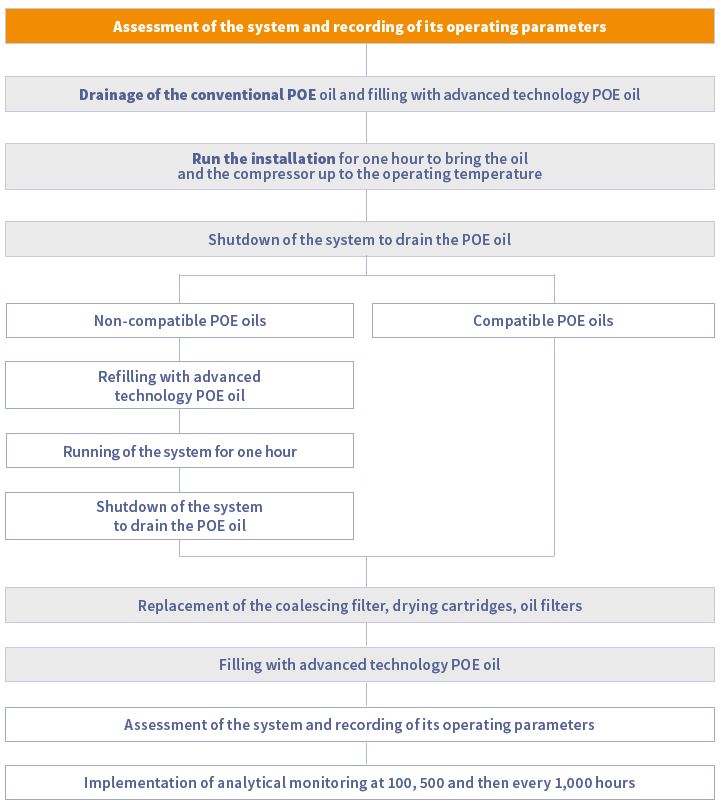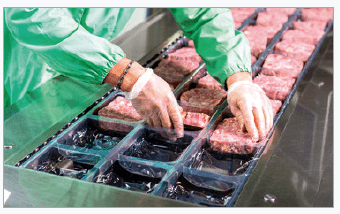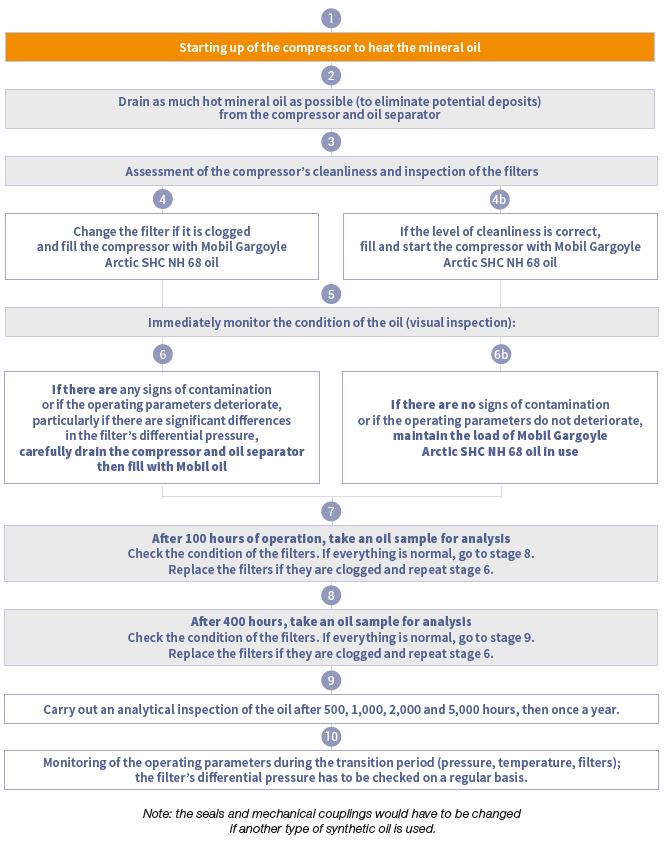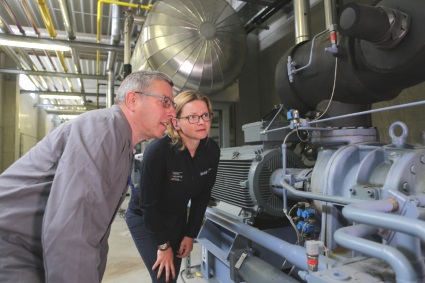Replacing the refrigerant lubricant is also advantageous.
When doing so, two characteristics have to be taken into account: the compatibility of the refrigerant / oil and maintaining or improving the system’s performance. Esso SAF, a subsidiary of the ExxonMobil Group, works on this challenge on a daily basis with Climalife and other refrigeration professionals. In this article we examine two procedures that are representative of the food production industry.
1. Procedure for converting a subcritical or transcritical CO2 installation (R-744) with POE oil to a new technology POE oil, Mobil SHC GargoyleTM 80 POE.
Aim: to save energy
The challenge posed by this type of system is to ensure optimal lubrication in hot and cold conditions. For highly soluble refrigerants, such as R-744 or R-1234ze, Mobil has developed an advanced technology polyolester oil, Mobil SHC™ Gargoyle Arctic 80 POE, which has a higher viscosity index than conventional POEs to ensure optimal lubrication and a low traction coefficient (friction of molecules together), which is synonymous with a possible reduction in energy use. The first stage of the conversion procedure is to check that the system’s current oil and the new Mobil oil are compatible on a physical-chemical level.

Proof of performance
 The SAS Abera plant, located in Saint-Brice-en-Coglès (France), is an abattoir that produces fresh and frozen meat. Using a conventional polyolester oil, Abera had problems with four reciprocating CO2 compressors caused by insufficient lubrication.
The SAS Abera plant, located in Saint-Brice-en-Coglès (France), is an abattoir that produces fresh and frozen meat. Using a conventional polyolester oil, Abera had problems with four reciprocating CO2 compressors caused by insufficient lubrication.
Using ExxonMobil’s new POE oil in Abera’s refrigeration compressors brought about several benefits :
- Viscosity index: 28% higher.
- Brookfield viscosity at -30°C: 68% lower.
- Traction coefficient: lower, measured on a mini-traction machine (MTM).
- Greater protection of sensitive parts from wear.
- Longer inspection and maintenance intervals.
- Lower temperatures in the oil sump and pistons.
- Fall in energy consumption.
2. Procedure for converting an ammonia-based system running on napthenic or paraffinic mineral oils to Mobil Gargoyle Arctic SHCTM NH 68 synthetic oil.
Aim: to improve the performance of the evaporators
Ammonia is a refrigerant that is commonly used in the food production industry. Historically, a large number of compressors contained mineral oil but a growing number use synthetic oils that perform better at a lower temperature as the oil is no longer trapped in the evaporators and can return easily to the compressor. In addition, the thermal stability and oxidation resistance of synthetic oils outperform those of mineral oils. This procedure is only possible with Mobil Gargoyle™ Arctic SHC NH 68 polyalphaolefin (PAO) synthetic oil and alkylbenzene (AB), which enable seals that were previously in contact with mineral oil to remain in place.

Proof of performance
 An ice-cream factory in Russia was operating refrigerant compressors lubricated with mineral oil. This system, which was subject to very low operating temperatures, had to be regularly topped up with mineral oil (up to 66 l/month for each unit with a capacity of 400 litres) and was affected by under-performance problems and oil-return difficulties as the oil remained trapped in the evaporators.
An ice-cream factory in Russia was operating refrigerant compressors lubricated with mineral oil. This system, which was subject to very low operating temperatures, had to be regularly topped up with mineral oil (up to 66 l/month for each unit with a capacity of 400 litres) and was affected by under-performance problems and oil-return difficulties as the oil remained trapped in the evaporators.
To ensure that the oil returns and to solve this problem, ExxonMobil’s engineers recommended the use of Mobil Gargoyle Arctic SHC NH 68 on the basis of its excellent fluidity when cold and specific formula that enables it to work with ammonia.
Using this oil brought about the following benefits :
- Reduction in the consumption of oil and top-ups.
- Optimisation of drainage intervals.
- No accumulation of oil in the evaporators: better oil return.
It should be noted that when draining a clogged circuit and as a replacement for mineral oils, Mobil Gargoyle™ Arctic SHC NH 68 oil can darken and deposits can accumulate in the filters. These phenomena are normal and are due to the solvent power of certain types of synthetic oil. In the case of highly clogged systems, consult Climalife’s technical department.
Conclusion
A change of technology, which improves energy efficiency, should not be taken lightly. Each case is different and demands a customised application procedure that is adapted to the systems and refrigerants used. Mobil and Climalife can assist you with the preparation and implementation of your projects. For your oil analyses, a periodic oil diagnostic test (“DPH A”) will enable you to monitor the new technology with the support of an expert.
Mobil and other similar brands are registered trademarks that belong to Exxon Mobil Corporation or one of its subsidiaries.

